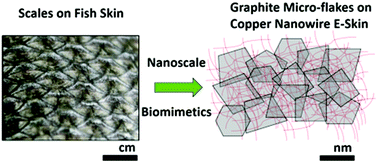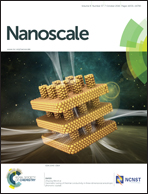Skin inspired fractal strain sensors using a copper nanowire and graphite microflake hybrid conductive network†
Abstract
This work demonstrates a facile “paint-on” approach to fabricate highly stretchable and highly sensitive strain sensors by combining one-dimensional copper nanowire networks with two-dimensional graphite microflakes. This paint-on approach allows for the fabrication of electronic skin (e-skin) patches which can directly replicate with high fidelity the human skin surface they are on, regardless of the topological complexity. This leads to high accuracy for detecting biometric signals for applications in personalised wearable sensors. The copper nanowires contribute to high stretchability and the graphite flakes offer high sensitivity, and their hybrid coating offers the advantages of both. To understand the topological effects on the sensing performance, we utilized fractal shaped elastomeric substrates and systematically compared their stretchability and sensitivity. We could achieve a high stretchability of up to 600% and a maximum gauge factor of 3000. Our simple yet efficient paint-on approach enabled facile fine-tuning of sensitivity/stretchability simply by adjusting ratios of 1D vs. 2D materials in the hybrid coating, and the topological structural designs. This capability leads to a wide range of biomedical sensors demonstrated here, including pulse sensors, prosthetic hands, and a wireless ankle motion sensor.


 Please wait while we load your content...
Please wait while we load your content...